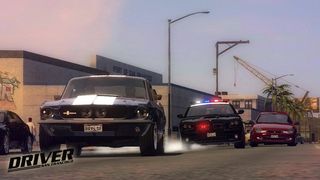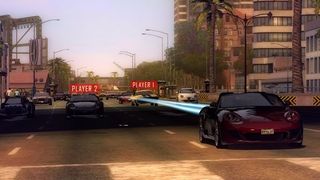Whatever happened to Driver? The first game showed so much promise as an effortless pastiche of classic ’70s car movies such as Bullitt, The French Connection and, well, Driver. It’s pretty roundly agreed, though, that as soon as the player was allowed to leave the car, which debuted in Driver 2: Back on the Streets, things went south faster than a rocket-powered swallow. Well now Ubisoft has found a way to replace the dreadful pedestrian sections without limiting you to a single car for the entirety of a mission.

The mechanic Ubisoft has come up with, called Shift, is a sort of strange astral projection-inspired method of car switching. With the touch of a button you suddenly zoom out of the cockpit Google Earth-style and find yourself hovering above the action with a free camera, able to drop into the drivers’ seat of any other car in the traffic below. The conceit that allows for this bizarre nonsense to happen is that Tanner, the original Driver’s lead character, is in a coma after a head-on collision with the antagonist from Driv3r, Charles Jericho.
Because the game takes place in Tanner’s dreams, he’s able to flit between everything from pokey Alfa Romeo MiTo’s to thunderous Pagani Zondas, as over 100 cars are in the game. Naturally the mechanic has to be tempered somehow, so you’ll have a Shift meter that depletes every time you’re outside of a vehicle. Spend too long umming and aahing about which ride to pick and it’ll run out. Fortunately, it can be built back up again by performing daring driving maneuvers, such as power slides, jumps and carving through oncoming traffic.

The Shift system upgrades as you progress through the game, eventually allowing you to zoom out and skip across the entire city in a matter of moments. Later, you’ll unlock Quick Shift, which allows you to quickly zip ahead to a marked vehicle that is also participating in a chase, for example.
Now it’d be easy to dismiss the storyline as pointless if it’s happening inside someone’s head, stories ending with “it was all a dream” are bad enough, let alone ones that start with it. Developers Ubisoft Reflections are keen to point out that Tanner’s coma dream is being affected by outside influences, presumably discussions that occur by his hospital bedside.
Also, don’t expect a dreamy, insubstantial plot inside Tanner’s head. Ubisoft Reflections also says that Tanner still thinks he’s an undercover cop, just one blessed with some kind of mystical superpower. He’ll still be performing investigations and attempting to get to the bottom of what’s going on, and the developer has hinted that this information might be useful when he finally awakes.

Unfortunately the game hardly announces itself with fanfare after we tried the game out in a multiplayer mode called Trailblazer. San Francisco seems lacking in color and character (draining the life out of this particular city means Reflections has achieved one near-impossible task at least) while the cars aren’t particularly stunning or their handling anything special.
Worst of all, the mode was designed to accommodate Shift and, as a result, was utterly without drama. For a start, instead of racing, the aim was to remain in the light trails behind a DeLorean that was cruising in laps around the city streets. As if this wasn’t pedestrian enough, the Shift mechanic ensured that if you screwed up you could instantly recover, ruining any sense of tension. We’re sure this isn’t the only multiplayer mode in the game, but if it’s the one Ubisoft thinks highlights the game at its best, the forecast for Driver: San Francisco is crap.

Reflections can still pull things off, as there are months until the game’s release. We have fond memories of the original Driver and, in spite of the Shift mechanic, the dev claims this game is a return to the roots of a series that’s lost its way. That said it needs to be a lot more impressive than what we’ve seen so far to make any kind of impact.
Aug 30, 2010
